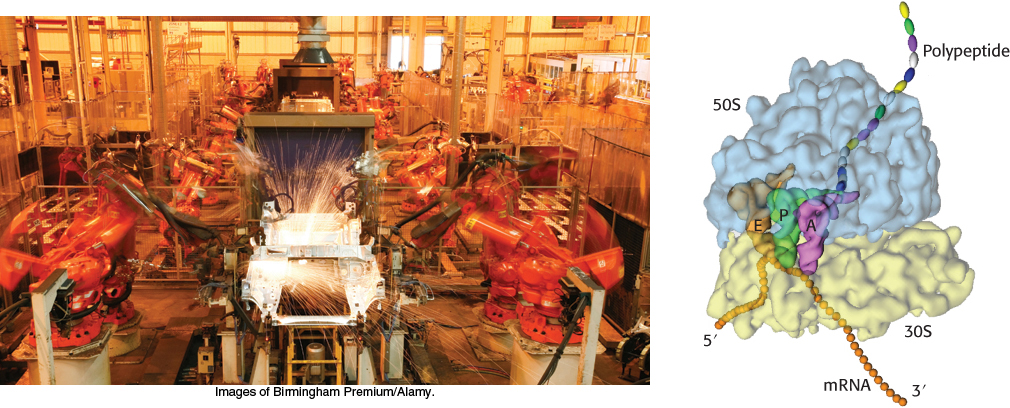
The ribosome, shown at the right, is a factory for the manufacture of polypeptides. Amino acids are carried into the ribosome, one at a time, connected to transfer RNA molecules. Each amino acid is joined to the growing polypeptide chain, which detaches from the ribosome only after the polypeptide has been completed. This assembly-line approach allows even very long polypeptide chains to be assembled rapidly and with impressive accuracy.
The genes that encode proteins are key components of the genetic information because proteins play most of the functional roles in cells. In Chapters 28 and 29, we examined how DNA is replicated and transcribed into RNA. We now turn to the mechanism of protein synthesis, a process called translation because the four-letter alphabet of nucleic acids is translated into the entirely different twenty-letter alphabet of proteins. Translation is a conceptually more complex process than either replication or transcription, both of which take place within the framework of a common base-pairing language. As befits its position linking the nucleic acid and protein languages, the process of protein synthesis critically depends on both nucleic acid and protein factors. Protein synthesis takes place on ribosomes—enormous complexes containing three large RNA molecules and more than 50 proteins. Interestingly, the ribosome is a ribozyme; that is, the RNA components catalyze protein synthesis. This observation strongly supports the notion that life evolved through an RNA world, and the ribosome is a surviving inhabitant of that world.
Transfer RNA molecules (tRNAs) and messenger RNA (mRNA) also are key participants in protein synthesis. The link between amino acids and nucleic acids is first made by enzymes called aminoacyl-tRNA synthetases. By specifically linking a particular amino acid to each tRNA, these enzymes translate the genetic code.
Although RNA is paramount in the process of translation, protein factors also are required for the efficient synthesis of a protein. Protein factors participate in the initiation, elongation, and termination of protein synthesis. This chapter focuses primarily on protein synthesis in bacteria because it illustrates many general principles and is well understood. Some distinctive features of protein synthesis in eukaryotes also are presented.
